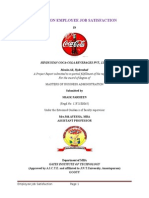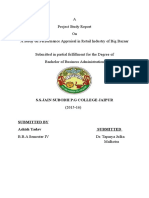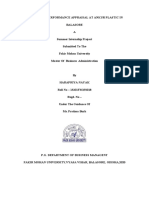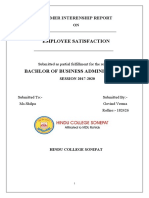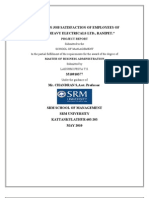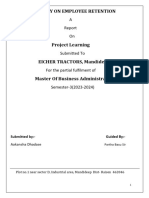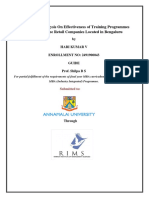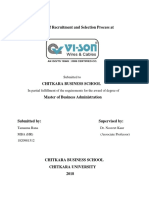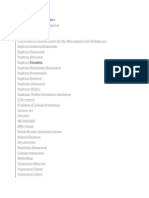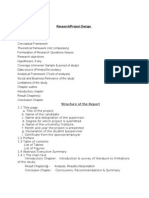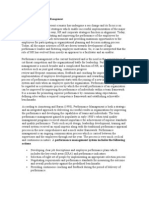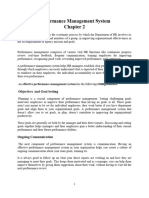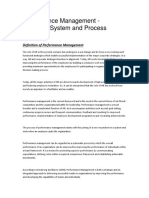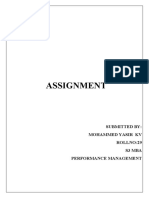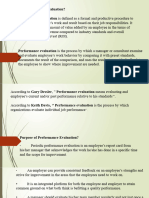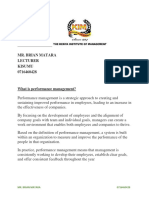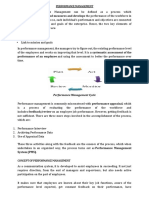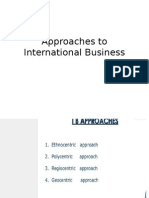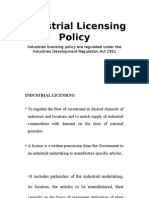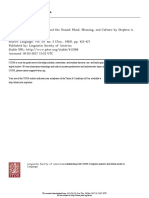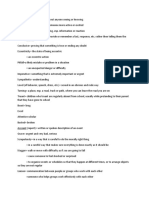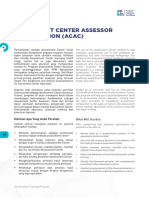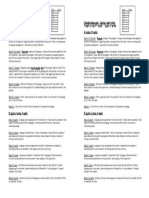Project Report On PMS
Project Report On PMS
Uploaded by
rohitbatraCopyright:
Available Formats
Project Report On PMS
Project Report On PMS
Uploaded by
rohitbatraOriginal Description:
Original Title
Copyright
Available Formats
Share this document
Did you find this document useful?
Is this content inappropriate?
Copyright:
Available Formats
Project Report On PMS
Project Report On PMS
Uploaded by
rohitbatraCopyright:
Available Formats
CHAPTER-1
COMPANY PROFILE
Ramani Ice Cream Co Pvt Ltd ( Top N Town ) - Introduction
"My team is my greatest strength and family expectation - my greatest motivation. My vision is to make
Top N Town the first choice of the customers and employees, by setting high standards in taste, service
delivery, employee satisfaction and price."
Arun Ramani,
Managing Director
Top N Town has been spreading smiles and sweetness for over forty glorious years now. What
started in 1970 in Bhopal as an ice cream brand by Late Shri Balchand Kukreja, has today
become a reason to celebrate life for millions across the country.
The business was taken ahead by his five grandsons, known as Ramani brothers, who made the journey
towards success creamy smooth with their vision, perseverance, networking skills and most importantly,
their love for ice cream. And the rest, as they say, is history. Today, with 200 exclusive parlours and more
than 10,000 retail outlets, Top N Town scoops out lip-smacking variety of 100% vegetarian ice creams,
sundaes, sorbets, shooters and shakes in eight states Chhattisgarh, Maharashtra, Rajasthan, Punjab,
Orissa, Uttar Pradesh, Madhya Pradesh and West Bengal.
Acknowledging health concerns of its customers, Top N Town also pioneered the production of low fat
and sugar free ice cream in Central India. To supply fresh products across all states, the Company has
plants at Bhopal and Durg (Chhattisgarh) with a combined production capacity of 1,00,000 litres a day.
Keeping with the times and changing tastes of customers, Top N Town, as an ice cream brand has come a
long way
Vision
To make Top N Town the first choice of the customers and employees, by setting high standards in taste,
service delivery and price.
Mission
o To deliver the ultimate ice cream experience to our customers by
Staying true to our commitment of providing best-in-class ice creams & desserts made
from healthy and premium ingredients
Delivering our prompt services, world-class dcor, and a selection wide enough to meet
each individuals need
Constantly delighting our customers to ensure that they keep coming back for more
o To be a great place to work where people are inspired to be the best they can be, by encouraging
creativity and innovation.
o To be a true leader in thought and action and ensure that all stakeholders in our business; whether
large or small; cherish and value the relationship.
Values
o Live Quality
o Passion for Excellence
o Encourage Innovation & Creativity
o Fairness & Integrity
o Adherence to Regulatory Environment
Quality
At Top N Town, we give maximum significance to the quality of our products and have got
certifications from Quality Management System ISO 9001 : ISO 22000 and Food Safety Management
System by IQNet and Quality Austria.
CHAPTER-2
INTRODUCTION TO THE TOPIC
Performance Management
The following definition is used for Performance Management:
This definition refers to a shift in scope from just registering the corporate results for accounting
purposes to effectively managing a rich and balanced set of organisational performance aspects,
ultimately helping to establish the enterprises strategic identity. Information technology does not
dominate this definition. Rather, IT is mentioned on par with, or better, as an enabler of adapted
management methodologies and models, the adoption of performance measurement techniques,
and integrated business process management.
Performance Management systems
Performance Management systems serve five different roles:
1. Measure performance
This category encompasses the role of monitor progress and measure performance/evaluates
performance.
2. Strategy management
This category comprises the roles of planning, strategy formulation, strategy
implementation/execution, and focus attention/provide alignment.
3. Communication
This category comprises the roles of internal and external communication, benchmarking and
compliance with regulations.
4. Influence behaviour
This category encompasses the roles of rewarding or compensating behaviour, managing
relationships and control.
5. Learning and improvement
This category comprises the roles of feedback, double-loop learning and performance
improvement.
OVERVIEW OF PERFORMANCE MANAGEMENT
The role of HR in the present scenario has undergone a sea change and its focus is on evolving
such functional strategies which enable successful implementation of the major corporate
strategies. In a way, HR and corporate strategies function in alignment. Today, HR works
towards facilitating and improving the performance of the employees by building a conducive
work environment and providing maximum opportunities to the employees for participating in
organizational planning and decision making process. Today, all the major activities of HR are
driven towards development of high performance leaders and fostering employee motivation. So,
it can be interpreted that the role of HR has evolved from merely an appraiser to a facilitator and
an enabler.
Performance management is the current buzzword and is the need in the current times of cut
throat competition and the organizational battle for leadership. Performance management is a
much broader and a complicated function of HR, as it encompasses activities such as joint goal
setting, continuous progress review and frequent communication, feedback and coaching for
improved performance, implementation of employee development programmes and rewarding
achievements. The process of performance management starts with the joining of a new
incumbent in a system and ends when an employee quits the organization. Performance
management can be regarded as a systematic process by which the overall performance of an
organization can be improved by improving the performance of individuals within a team
framework. It is a means for promoting superior performance by communicating expectations,
defining roles within a required competence framework and establishing achievable benchmarks.
A performance management process sets the platform for rewarding excellence by aligning
individual employee accomplishments with the organizations mission and objectives and
making the employee and the organization understand the importance of a specific job in
realizing outcomes. By establishing clear performance expectations which includes results,
actions and behaviors, it helps the employees in understanding what exactly is expected out of
their jobs and setting of standards help in eliminating those jobs which are of no use any longer.
Through regular feedback and coaching, it provides an advantage of diagnosing the problems at
an early stage and taking corrective actions.
To conclude, performance management can be regarded as a proactive system of managing
employee performance for driving the individuals and the organizations towards desired
performance and results. Its about striking a harmonious alignment between individual and
organizational objectives for accomplishment of excellence in performance.
Objectives of Performance Management
According to Lockett (1992), performance management aims at developing individuals with the
required commitment and competencies for working towards the shared meaningful objectives
within an organizational framework. Performance management frameworks are designed with
the objective of improving both individual and organizational performance by identifying
performance requirements, providing regular feedback and assisting the employees in their
career development. The main goal of performance management is to ensure that the
organization as a system and its subsystems work together in an integrated fashion for
accomplishing optimum results or outcomes.
The major objectives of performance management are discussed below:
1. To enable the employees towards achievement of superior standards of work
performance.
2. To help the employees in identifying the knowledge and skills required for performing
the job efficiently as this would drive their focus towards performing the right task in the
right way.
3. Boosting the performance of the employees by encouraging employee empowerment,
motivation and implementation of an effective reward mechanism.
4. Promoting a two way system of communication between the supervisors and the
employees for clarifying expectations about the roles and accountabilities,
communicating the functional and organizational goals, providing a regular and a
transparent feedback for improving employee performance and continuous coaching.
5. Identifying the barriers to effective performance and resolving those barriers through
constant monitoring, coaching and development interventions.
Some of the key concerns of a performance management system in an organization are:
a) Concerned with the output (the results achieved), outcomes, processes required for
reaching the results and also the inputs (knowledge, skills and attitudes).
b) Concerned with measurement of results and review of progress in the achievement of set
targets.
c) Concerned with defining business plans in advance for shaping a successful future.
d) Striving for continuous improvement and continuous development by creating a learning
culture and an open system.
e) Concerned with the provision of procedural fairness and transparency in the process of
decision making.
The performance management approach has become an indispensable tool in the hands of the
corporates as it ensures that the people uphold the corporate values and tread in the path of
accomplishment of the ultimate corporate vision and mission. It is a forward looking process as it
involves both the supervisor and also the employee in a process of joint planning and goal setting
in the beginning of the year.
Components of Performance Management System
Any effective performance management system includes the following components:
1. Performance Planning: Performance planning is the first crucial component of any
performance management process which forms the basis of performance appraisals. Performance
planning is jointly done by the appraisee and also the reviewee in the beginning of a performance
session. During this period, the employees decide upon the targets and the key performance areas
which can be performed over a year within the performance budget., which is finalized after a
mutual agreement between the reporting officer and the employee.
2. Performance Appraisal and Reviewing: The appraisals are normally performed twice in a
year in an organization in the form of mid reviews and annual reviews which is held in the end of
the financial year. In this process, the appraisee first offers the self filled up ratings in the self
appraisal form and also describes his/her achievements over a period of time in quantifiable
terms. After the self appraisal, the final ratings are provided by the appraiser for the quantifiable
and measurable achievements of the employee being appraised.
3. Feedback on the Performance followed by personal counseling and performance
facilitation: Feedback and counseling is given a lot of importance in the performance
management process. This is the stage in which the employee acquires awareness from the
appraiser about the areas of improvements and also information on whether the employee is
contributing the expected levels of performance or not.
4. Rewarding good performance: This is a very vital component as it will determine the work
motivation of an employee. During this stage, an employee is publicly recognized for good
performance and is rewarded. This stage is very sensitive for an employee as this may have a
direct influence on the self esteem and achievement orientation. Any contributions duly
recognized by an organization helps an employee in coping up with the failures successfully and
satisfies the need for affection.
5. Performance Improvement Plans: In this stage, fresh set of goals are established for an
employee and new deadline is provided for accomplishing those objectives. The employee is
clearly communicated about the areas in which the employee is expected to improve and a
stipulated deadline is also assigned within which the employee must show this improvement.
This plan is jointly developed by the appraisee and the appraiser and is mutually approved.
6. Potential Appraisal: Potential appraisal forms a basis for both lateral and vertical movement
of employees. By implementing competency mapping and various assessment techniques,
potential appraisal is performed. Potential appraisal provides crucial inputs for succession
planning and job rotation.
Benefits of a Performance Management System
A good performance management system works towards the improvement of the overall
organizational performance by managing the performances of teams and individuals for ensuring
the achievement of the overall organizational ambitions and goals. An effective performance
management system can play a very crucial role in managing the performance in an organization
by:
Ensuring that the employees understand the importance of their contributions to the
organizational goals and objectives.
Ensuring each employee understands what is expected from them and equally
ascertaining whether the employees possess the required skills and support for fulfilling
such expectations.
Facilitating a cordial and a harmonious relationship between an individual employee and
the line manager based on trust and empowerment.
Role of HR in Performance Management
The HR department today is a strategic partner and plays a vital role in pursuing a particular
strategy. For facing the challenges of a globalized world, Indian organizations have reformed
their HRM strategies for managing the employee performance by considering part time work,
outsourcing and temporary workers. HR no longer today plays the role of a rubber stamp
department, rather is a performance enabler by closely working with the management and all the
major functional departments of an organization. Companies like Maruti Udyog Ltd. and
Mahindra and Mahindra, revamped their entire organizational set up and were able to create
performance efficiency due to the efforts of the HR department.
CHAPTER-3
REVIEW OF LITERATURE
REVIEW OF LITERATURE
Tata Iron and Steel Company (TISCO), a flagship company of India involved in manufacturing
of cost effective steel can be appreciated for their initiatives in the implementation of an effective
performance management framework and innovative HR practices. TISCO initiated a
management restructuring programme for transforming into a high performing and a growing
organization. In the HR front, the management focused on providing exciting career
opportunities and building a team of high performing professionals for which they hired
Mckinsey and Co. The consultants firstly started with building a lean and a flat strategic business
unit with enriched jobs, increased accountabilities and autonomy. A Performance Ethic
Programme (PEP) was also introduced for promoting young and dynamic professionals and this
was a replacement of seniority based promotions. A new Performance Management System
(PMS) was introduced for aligning the KRAs with the business strategies and identifying
superior performers in the organization by defining clear career paths and accountabilities. The
rewards and recognitions were linked with the PMS. The new measures in the direction of
performance management boosted the employees motivation and performance. The job
satisfaction also improved due to the introduction of a fair and transparent reward system.
Arvind Mills of LalbhaiGroup, realized the importance of strategic HRM practices and the
implementation of a pro active performance management system in their organization after
facing serious threats from the business competitors. The company created a Manpower Planning
and Resource Group which took the charge of preparing job descriptions and structuring the jobs
for the employees and was responsible for implementing the recruitment and selection
procedures. An innovative online recruitment system was introduced which was known as
Selection Information System, for fixing interviews, generating call letters, etc. This system was
linked with the Compensation Information System and Training Information System. The
training requirements of the employees were taken care by the Management and Organizational
Development Group. The company also introduced MBO system, for setting smart goals for the
employees which may motivate them for a superior performance.
Organizations like Wipro and Infosys, the major IT giants of India give a lot of importance to
competency based performance management system. In Wipro, the performance management
process begins with the identification and assessment of critical competencies for top
management, senior management and middle management on the basis of critical incidents,
focus groups and rigorous interviews. 360 degree feedback is used for providing a feedback on
the existing competencies of the employees and based on the results of the feedback a training
programme is organized for improving the deficit areas of performance. Finally, personal
development plans are formulated for each employee for monitoring and tracking the
improvement in competencies or skill sets. For building competencies, Wipro focuses on
strategic thinking, vision, building star performers and global focus. Infosys equally gives a lot
of importance to 360 degree feedback for evaluating the critical leadership competencies of their
employees.
OBJECTIVES
1. To study the process of PMS in Ramani Ice Cream Co Pvt Ltd ( Top N Town )
2. To know the effectiveness of PMS (Performance Management System) on employees
performance & to assess the satisfaction level of employees towards the existing PMS
3. To identify the problems which create obstacles in the appraisal system & give suggestions to
make the study more result oriented.
CHAPTER-4
RESEARCH METHODOLOGY
RESEARCH: Descriptive research
RESEARCH INSTRUMENT: Structured Questionnaire
Research Hypothesis
Null Hypothesis (Ho): The PMS of Ramani Ice Cream Co Pvt Ltd ( Top N Town ) is not
effective.
Alternative Hypothesis (Ha): The PMS of Ramani Ice Cream Co Pvt Ltd ( Top N Town ) is
effective.
SAMPLING FRAME: It is a representation of the elements of the target population. It consists
of a list or set of directions for identifying the target population. In our study sample frame
consist of list of all the employees at various levels.
SAMPLE METHOD
i) Sample Method: Convenience and stratified sampling
ii) Sample Size: 34
iii) Sample Unit: Every single element of the sampling frame is a sampling unit.
In this project sampling unit is each and every employee of Ramani Ice Cream Co Pvt Ltd ( Top
N Town ) working at staff, officer, executive or manager level in various functional departments.
Source of Data
1. Collection of Data: following are the sources of data collection:
(a) Primary source: original data is collected to know the opinion of respondents
regarding the working of H.R department. Following are the research instruments that
are used to collect the data:
Observation: direct observation method is used to understand the procedures
and the working of the H.R department.
Questionnaires: questionnaire is prepared with open ended and close ended
questions to collect information regarding PMS of the company.
Interview: The data is collected through interviews and interaction with the
people who are related to PMS in Ramani Ice Cream Co Pvt Ltd ( Top N Town )
(b) Secondary source: data which is already being collected by the company is referred to
understand the working of the H.R department.
Manual: personnel manual of the company is referred to understand the policies
and procedures in every function of H.R department.
Documents and Reports: The data is collected from the documents which are
maintained by the company related to the PMS procedure of H.R department.
Internet and Books: various H.R sites are surfed and books are referred to
collect data regarding PMS.
Areas of Study:
The area of the study is Ramani Ice Cream Co Pvt Ltd ( Top N Town )
Limitation of the study
1. The sample size includes few senior managers and hence the results can have a degree of
variation.
2. The response of the employees in giving information was lukewarm.
3. Employees were reluctant in marking correct answer because of any future action or
query from organization.
4. Organizations resistance to share the internal information.
CHAPTER-5
OBSERVATIONS AND ANALYSIS:-
Analysis and interpretation
Q1. Since how many years you have been working in this organization?
a. Below 1 yr b. b/w 1-3 yrs c. above 3 yrs
3 16 15
Interpretation: The above data reveals that the employees were normally there in the
organization b/w 1-3yrs or above 3 yrs. Thus the PMS was applicable to them.
3
16
15
below 1yr
b/w 1-3yr
above 3yrs
Q2.Do you think PMS is clearly defined in the organization?
a. Strongly agree 3
b. Agree 19
c. Disagree 11
d. Strongly disagree 1
Interpretation: The data reveals that many employees have agreed to this which means that the
performance management system is clearly defined in this organization.
a. Strongly agree
b. Agree
c. Disagree
d. Strongly disagree
Q3. Do you think all the factors facilitating and hindering performance are taken into
consideration while appraising the performance?
a. Strongly agree 2
b. Agree 24
c. Disagree 8
d. Strongly disagree 0
Interpretation: Seeing the above data and the graph it is clear that many of the employees agree
with the fact that the factors which hinder the performance are taken into account while
developing the PMS so that all employees can be satisfied. No employee denied this fact.
a.
Strongl
y agree
6%
b. Agree
71%
c. Disagree
23%
d. Strongly
disagree
0%
Graph 3
Q4. Goals set for performance evaluation are mutually decided goals?
a. Strongly agree 6
b. Agree 21
c. Disagree 7
d. Strongly disagree 0
Interpretation: Given data reveals that the company while deciding its performance standards
mutually set goals for achieving the target and are clearly defined.
graph 4
a. Strongly agree
b. Agree
c. Disagree
d. Strongly disagree
Q5. Does performance of employees improve due to PMS?
a. Strongly agree 8
b. Agree 19
c. Disagree 5
d. Strongly disagree 2
Interpretation: The respondents agree that the performance is improved due to PMS. But many
disagree that performance is not improved and PMS is just a secondary aspect of performance
appraisal.
graph 7
a. Strongly agree
b. Agree
c. Disagree
d. Strongly disagree
Q6. Do the PMS implemented in the organization create a participative environment?
a. Yes 19
b. No 7
c. To some extent 6
d. Not at all 2
Interpretation: The employees in the organization feel that PMS creates a participative
environment in the working of the organization as the goals are mutually achieved so as to bring
better results.
But on the other hand 40% of the employees think that it does not create a participative
environment.
19
7
6
2
a. Yes
b. No
c. To some extent
d. Not at all
Q7. Are the promotions strictly based on PMS?
a. Strongly agree 4
b. Agree 14
c. Disagree 13
d. Strongly disagree 3
Interpretation: The data and the graph shows that employees feel that yes promotions are based
on PMS but then many employees do not agree to the fact that promotions are wholly based on
PMS but there are some other considerations also.
12%
41%
38%
9%
graph 9
a. Strongly agree
b. Agree
c. Disagree
d. Strongly disagree
Q8. Do you think leadership and interpersonal skills are developed due to PMS?
a. Strongly agree 2
b. Agree 23
c. Disagree 8
d. Strongly disagree 1
Interpretation: This is a revealed fact that leadership and interpersonal skills enhance through
PMS as employees are aware of their key areas on which they will be assessed. Thus the
employees of Ramani Ice Cream Co Pvt Ltd ( Top N Town ) agree to the fact that skills are
enhanced through PMS.
6%
68%
23%
3%
Sales
a. Strongly agree
b. Agree
c. Disagree
d. Strongly disagree
Q9. Do you feel free to express your appraiser, your disagreement regarding the appraisal
decisions?
Interpretation: It is clear from the responses that the employees are not so open to the appraiser
and do not feel free to express their views to the appraiser regarding any disagreement in case of
appraisal decisions.
But some of the employees also feel that they are free to express their views to the appraiser
regarding any disapproval.
39%
6%
52%
3%
graph 11
a. Always
b. Often
c. Sometimes
d. Never
a. Always 12
b. Often 2
c. Sometimes 16
d. Never 1
Q10. Your job description clearly defines KRAs on which your performance is rated?
a. Strongly agree 6
b. Agree 21
c. Disagree 6
d. Strongly disagree 1
Interpretation: The graph shows that the employees agree to the fact that their job description
clearly defines KRAs on which their performance is rated, thus they keep a check on their main
working areas and try to do it sincerely.
6
21
6
1
0
5
10
15
20
25
a. Strongly agree b. Agree c. Disagree d. Strongly
disagree
a. Strongly agree
b. Agree
c. Disagree
d. Strongly disagree
Q11. Effective Pms is helpful in reducing grievance among employees?
a. Yes 20
b. No 8
c. To some extent 6
Interpretation: 59% of the respondents agree to the fact that their grievance is reduced by the
way the PMS is defined. 23% of the respondents deny the fact of grievance reduction. 17% of
the respondents said that to some extent it is a helpful tool in grievance reduction.
0
2
4
6
8
10
12
14
16
18
20
a. Yes b. No c. To some extent
20
8
6
a. Yes
b. No
c. To some extent
Q12. The PMS helps to identify the strength and weakness of the employees?
a. Strongly agree 6
b. Agree 24
c. Disagree 4
d. Strongly disagree 0
Interpretation: The data reveals that 70% of the employees agree to the fact that PMS as a tool
helps to identify the strength and weakness of the employees. Around 15% deny the fact that it is
not a useful tool.
0
5
10
15
20
25
a. Strongly
agree
b. Agree
c. Disagree
d. Strongly
disagree
6
24
4
0
graph 14
a. Strongly agree
b. Agree
c. Disagree
d. Strongly disagree
Q13. PMS keeps a check on the major achievement & failure or success of work?
a. Strongly agree 4
b. Agree 24
c. Disagree 6
d. Strongly disagree 0
Interpretation: This is clear from the graph and the data that 70% of the respondents feel that
PMS keeps a check on the major achievement and failure or success of work. 18% respondents
disagree the fact that it does not keep a check on the failure and success of work.
a. Strongly agree
12%
b. Agree
70%
c. Disagree
18% d. Strongly
disagree
0%
graph 15
Q14. Does your company have a separate committee to review the PMS?
a.Yes 10
b. No 24
Interpretation: It is clear from the graph that there is no separate committee for evaluating the
performance but the top management itself exercises all the functions. Thus PMS is not present
in Ramani Ice Cream Co Pvt Ltd ( Top N Town ).
0
5
10
15
20
25
a. Yes
b. No
10
24
graph 16
a. Yes
b. No
Q15. Performance rating helps to fix increment?
a. Strongly agree 0
b. Agree 17
c. Disagree 13
d. Strongly disagree 4
Interpretation: The data reveals that 50% i.e. half the employees agree to the fact that the
promotions are strictly based on PMS.
a. Strongly agree
0%
b. Agree
50%
c. Disagree
38%
d. Strongly disagree
12%
graph 16
Q16. How frequently the PMS is done in the organization?
a.once in 6 months 6
b. once in a year 20
c. Once achieving targets 3
d. Rarely 5
Interpretation: The graph shows that PMS is done once in a year to assess the overall
performance of the employees.
0
5
10
15
20
a. once in 6
months
b. once in a
year
c. Once
achieving
targets
d. Rarely
6
20
3 5
graph 19
a. once in 6 months
b. once in a year
c. Once achieving targets
d. Rarely
Open-ended questions
Q17. Are you satisfied with the existing PMS? If not satisfied then why?
Table 17
a. Highly satisfied 0
b. Satisfied 24
c. Dissatisfied 10
d. Highly dissatisfied 0
Chart 17
Interpretation: Many employees are satisfied with the existing PMS. But some are not.
The reasons for dissatisfaction are:
1. Because it doesnt judge their potential exactly.
2. Growth is not concentrated on PMS.
3. They do not find any PMS in the company.
4. Marking is not appropriately done.
0%
71%
29%
0%
a. Highly satisfied
b. Satisfied
c. Dissatisfied
d. Highly dissatisfied
5. The existing PMS is not based on merit basis and at the end of it there is not much difference
in the performance of high potential employee and average potential employee.
Q18. What changes do you expect the company to inbuilt in PMS?
The suggestions were:
1. PMS must be rated and TRAINING and AWARENESS should be there.
2. More clear and transparent system should be followed. It should not be biased.
3. It should be timely done i.e. in 6months or so.
4. It should be done on merit basis also.
5. Quick decision making should be followed.
6. A separate committee should be formed for PMS.
7. 360 degree appraisal must be implemented.
8. Proper communication should be there b/w the employees and the Top Management.
Q22. Do you find more opportunities after PMS?
The suggestions were:
1. A strong & proper PMS will increase opportunities.
2. Yes in terms of job rotation and work.
3. Yes it provides opportunity to sharpen the strengths and weakness of employees.
4. Yes we are able to work in other areas also which is not related to our job.
5. Candidates having good potential are earmarked and a path for growth is decided.
6. Yes, but only its implementation in the organization as a whole.
Q19. Two good things and two bad things about PMS and the organization?
The responses were:
Good things about organization:
1. Working culture is good.
2. Colleagues are cooperative in nature.
3. Opportunities are high.
Bad things about the organization:
1. Some transparency is missing.
2. Some job profiles are not sound according to the working capacities.
3. Not satisfied with the management working.
4. Policies are not clear.
Good things about PMS:
1. Enhances individual skills.
2. Employee gets to know about his/her strengths and weakness from the parameters defined.
3. Helps to achieve goals.
4. It provides healthy competition.
5. It builds self-confidence and motivates the employees.
Bad things about PMS:
1. Lack of consistency.
2. Not based on performance or merit.
3. Review is not done periodically.
4. There are many loopholes in PMS of the organization.
5. Creates grievances among employees.
CHAPTER-6
FINDINGS
FINDINGS:
Nature of effectiveness of PMS is satisfactory at Ramani Ice Cream Co Pvt Ltd ( Top N
Town )
All the parameters are well defined in the organization.
The process and function of PMS is not well stated in the organization.
Factors facilitating and hindering performance are taken into consideration.
PMS is able to create participative environment.
Employees are not satisfied with the fairness of management in terms of reward and
recognition.
Training list provided in PMS list is unable to cater all the training needs for employees
Managers involvement in training program is very less according to the prescribed
norms.
Employees are not satisfied with the conduction of PMS i.e. it is not timely practiced.
There is no separate committee for PMS.
CHAPTER-7
RECOMMENDATIONS
RECOMMENDATIONS:
The following are the suggestions and conclusions derived from this particular
Research study
Objectivity
One manager's idea of "self-starting ability" can be quite different than another's idea. If greater
amount of objectivity can be infused into the system, it can help to bring more transparency.
.
Effective Communication
One function of performance appraisals is to help employees develop so they can contribute
more effectively. In order for the employees to develop and learn they need to know what they
need to change, where (specifically) they have fallen short, and what they need to do. If a
manager assigns a 1 (unsatisfactory) on a scale of 5, it does not convey much information to an
employee. It just says the manager is dissatisfied with something. In order to make it meaningful
and promote growth, far more information must be added to the appraisal process and the related
information should be transparently shared with the employee.
Fairness
Most employees resist being classified at the low end of the scale. Employees who are low rated
are more likely to resist the evaluation of the superior and argue, claiming that personal bias was
involved in the ratings.
Managerial Efficiency
The implementation of a Performance Management System rests on the shoulders of the
manager and he must ensure that it is done properly. A good manager can make an average
appraisal system work and vice-versa.
Training development / enhancement
Proper training program should be conducted about the E-Map system for the new trainees.
Some personality development trainings should also be provided apart from mere job oriented
training.
Increase transparency
Increase transparency in the organization by giving ample and adequate amount of information
of system. HR department should follow an open door policy which ensures that any queries
regarding the policy can be clarified to the employee s satisfaction.
Timely review
If PMS is conducted within 6 months then surely the results will be much better and would bring
more satisfaction in employees. It will also increase the dedication to work hard as they will be
assessed on their goals within a stipulated time.
CHAPTER-8
CONCLUSION
CONCLUSION
HR department is one of the major part of any organization its goal is to maximize the
productivity of an organization by optimizing the effectiveness of its employees while
simultaneously improving the work life of employees and treating employees as valuable
resources. Human resource managers attempt to determine future HRM activities and plan
for the implementation of HRM procedures to help companies realize their goals.
RAMANI ICE CREAM CO PVT LTD ( Top N Town ) HR department is one of several
departments which are vying for input of the strategic level at the decision making process
within organization and it subscribes to the belief that efficiency, effectiveness and success of
the organization depends largely on the skills, abilities and commitment of the employees
who constitute the most important asset of the organization. Here it is responsible for proper
regulation of policies, employees development, and maintenance of data and records of
employees, providing them ample benefits so that the best employees can be retained with
them and ensures High performance. And also strives to make the organization worlds
largest power company.
And Ramani Ice Cream Co Pvt Ltd ( Top N Town ) is able to manage all this by providing
the effective mean of Performance Management System which enhances the employees
competencies.
CHAPTER-9
LEARNING OUTCOME
LEARNING OUTCOME
The practical approach is the best way of learning and thus internship during the BBA course
serves the same purpose. Industrial exposure during the internship helps in providing the real
insight to the business world and show how theoretical concepts taught in the class rooms are
actually applied in the business. A good and effective Performance Management system is very
important for any organization as it increases to improve its efficiency.
I have learnt about Ramani Ice Cream Co Pvt Ltd ( Top N Town ), its vision, mission, their
corporative strategy, their working culture, their policy.
A detailed study of HR department, its sections, working of different sections and how it benefits
the employees.
A study on Performance Management System (PMS) and it how it helps in appraising employee.
ANNEXURE
Q1. Since how many years you have been working in this organization?
a. below 1 yr b. b/w 1-3 yrs c. above 3 yrs
Q2. Do you think PMS is clearly defined in the organization?
a. Strongly agree b. Agree
c. Disagree d. Strongly disagree
Q3. Do you think all the factors facilitating and hindering performance are taken into
consideration while appraising the performance?
a. Strongly agree b. Agree
c. Disagree d. Strongly disagree
Q4. Goals set for performance evaluation are mutually decided goals?
a. Strongly agree b. Agree
c. Disagree d. Strongly disagree
Q5. Does performance of employees improve due to PMS?
a. Strongly agree b. Agree
c. Disagree d. Strongly disagree
Q6. Do the PMS implemented in the organization create a participative environment?
a. Yes b. No
c. To some extent d. Not at all
Q7. Are the promotions strictly based on PMS?
a. Strongly agree b. Agree
c. Disagree d. Strongly disagree
Q8. Do you think leadership and interpersonal skills are developed due to PMS?
a. Strongly agree b. Agree
c. Disagree d. Strongly disagree
Q9. Your job description clearly defines KRAs on which your performance is rated?
a. Strongly agree b. Agree
c. Disagree d. Strongly disagree
Q10. Pms is helpful in reducing grievance among employees?
a. Yes b. No
c. To some extent
Q11. The PMS helps to identify the strength and weakness of the employees?
a. Strongly agree b. Agree
c. Disagree d. Strongly disagree
Q12. PMS keeps a check on the major achievement & failure or success of work?
a. Strongly agree b. Agree
c. Disagree d. Strongly disagree
Q13. Does your company have a separate committee to review the PMS?
a. Yes b. No
Q14. Performance rating helps to fix increment?
a. Strongly agree b. Agree
c. Disagree d. Strongly disagree
Q15. How frequently the PMS is done in the organization?
a. Once in 6 months b. Once in a year
c. Once achieving targets d. Rarely
Q16. Are you satisfied with the existing PMS?
a. Highly satisfied b. Satisfied
c. Dissatisfied d. Highly dissatisfied
If not satisfied then y?
Q17. What changes do you expect the company to inbuilt in PMS?
Q18. Do you find more opportunities after PMS?
Q19. Two good things and two bad things about PMS and the organization?
BIBLIOGRAPHY
1) Concerned Websites
www.google.co.in
www.cithr.com
www.karmayog.com
www.csmworld.com
www.businessworld.com
www.managementpardise.com
www.topntown.com
2) Magazines & journals.
Human Resource Management : country Experience by: V.S.RAO
Company profile
Company Report
Company Organizational Manual
3) Primary Data.
4) Interaction with company respondents.
You might also like
- Coca-Cola ProjectDocument96 pagesCoca-Cola ProjectDr-Afzal Basha HS100% (6)
- RSPLDocument50 pagesRSPLAastha Saraswat50% (2)
- Performance Appraisal of The Employes in Jindal Brother Pvt. Ltd.Document31 pagesPerformance Appraisal of The Employes in Jindal Brother Pvt. Ltd.Harsh KardamNo ratings yet
- Performance Appraisal at KMBDocument66 pagesPerformance Appraisal at KMBKrishna ChodasaniNo ratings yet
- Abhinav Reddy Quality of Work Life at HDFC BankDocument79 pagesAbhinav Reddy Quality of Work Life at HDFC BankSri0% (1)
- MBA Project Report Total Quality ManagementDocument8 pagesMBA Project Report Total Quality ManagementAnand Sagar100% (3)
- A Study On Employee Motivation at Tata MotorsDocument6 pagesA Study On Employee Motivation at Tata MotorsManoj Kumar40% (5)
- Big BazzarDocument44 pagesBig BazzarAshish Yaduvanshi79% (14)
- A Study On Absenteeism of WorkmenDocument47 pagesA Study On Absenteeism of WorkmenShatheesh Lingam100% (6)
- Training & Development Survey at BSNL Mba HR Project ReportDocument74 pagesTraining & Development Survey at BSNL Mba HR Project ReportBabasab Patil (Karrisatte)100% (2)
- AJISH ProjectDocument70 pagesAJISH ProjectveeerajNo ratings yet
- Training and Development Mba ProjectDocument81 pagesTraining and Development Mba ProjecteswarNo ratings yet
- Dissertation Report PDFDocument28 pagesDissertation Report PDFNATIONAL XEROXNo ratings yet
- My Final Mba HR Payroll ProjectDocument73 pagesMy Final Mba HR Payroll Projectsandy sandhyaNo ratings yet
- Top 10 ECommerce Companies in India 2015Document23 pagesTop 10 ECommerce Companies in India 2015rohitbatraNo ratings yet
- Power ThinkingDocument1 pagePower Thinkingrohitbatra100% (2)
- CthulhuTech - Dark PassionsDocument72 pagesCthulhuTech - Dark PassionsMaddalena Gattoni90% (10)
- A Study On Performance Appraisal at Ankur Plastic In-1Document65 pagesA Study On Performance Appraisal at Ankur Plastic In-1Sushma MishraNo ratings yet
- Performance Appraisal NewDocument82 pagesPerformance Appraisal NewRaj KingNo ratings yet
- Introduction of Performance AppraisalDocument23 pagesIntroduction of Performance AppraisalUDayNo ratings yet
- Employee Satisfaction Project FinalDocument65 pagesEmployee Satisfaction Project Finalghoshsubhankar1844No ratings yet
- MBA PROJECT Reliance Energe Employee EngagementDocument85 pagesMBA PROJECT Reliance Energe Employee EngagementAakash Pareek100% (2)
- Employee Motivation in It SectorDocument69 pagesEmployee Motivation in It Sectoranushka goel100% (1)
- Employee MotivationDocument115 pagesEmployee MotivationravikumarreddytNo ratings yet
- SIP (Biswabijanta Rout)Document64 pagesSIP (Biswabijanta Rout)Ashis SahooNo ratings yet
- HR ProjectDocument120 pagesHR ProjectSiddhant RanjanNo ratings yet
- Appendix A Study On Performace Appraisal in Brainstorm InfotechDocument3 pagesAppendix A Study On Performace Appraisal in Brainstorm InfotechSivalinga RajaNo ratings yet
- Project On Employee SatisfactionDocument64 pagesProject On Employee SatisfactionRuby SiddiquiNo ratings yet
- BBA Final Year ProjectDocument80 pagesBBA Final Year ProjectSai Printers100% (3)
- D. Annexure Questionnaire On Job SatisfactionDocument3 pagesD. Annexure Questionnaire On Job Satisfactionmyid123dvg0% (1)
- Employee Satisfaction ProjectDocument77 pagesEmployee Satisfaction ProjectMonika Verma100% (2)
- Training and Development Program in BhelDocument57 pagesTraining and Development Program in BhelNAVEEN ROY0% (1)
- Bhel ProjectDocument92 pagesBhel ProjectMazhar Sarwash75% (4)
- Project Report ON "Performance Appraisal": Dabur India Limited (Sahibabad Unit)Document70 pagesProject Report ON "Performance Appraisal": Dabur India Limited (Sahibabad Unit)georgecool_2006No ratings yet
- Employee Retention Internship ReportDocument25 pagesEmployee Retention Internship ReportAakansha DhadaseNo ratings yet
- A Project Report On "Study of Recruitment and Training" inDocument59 pagesA Project Report On "Study of Recruitment and Training" inshyamindia100% (4)
- SIP Project Report FormatDocument10 pagesSIP Project Report FormatMayank Sahu100% (1)
- MBA Internship Project HRDocument3 pagesMBA Internship Project HRNeha DhawanNo ratings yet
- A Study of Performance Management System in HCLDocument5 pagesA Study of Performance Management System in HCLSagar PatidarNo ratings yet
- Performance AppraisalDocument55 pagesPerformance AppraisalDipayan Singha100% (1)
- Mba HR PROJECTDocument95 pagesMba HR PROJECTshashank kumarNo ratings yet
- A Study On Recruitment and Selection at New TV Center (Samsung) in Nashik, MaharashtraDocument110 pagesA Study On Recruitment and Selection at New TV Center (Samsung) in Nashik, MaharashtraChandan SrivastavaNo ratings yet
- P.M-1Document89 pagesP.M-1spsurya20130% (2)
- Employee EngagementDocument65 pagesEmployee Engagementakash sharmaNo ratings yet
- Performance Appraisal - Review of LiteratureDocument4 pagesPerformance Appraisal - Review of LiteratureAmarnath Shun NadarNo ratings yet
- Job Satisfaction and Fullfillment - Coca ColaDocument66 pagesJob Satisfaction and Fullfillment - Coca ColaMohmmedKhayyumNo ratings yet
- Performance Appraisal in Surya Up Gramin Bank Panjab National (PNB)Document88 pagesPerformance Appraisal in Surya Up Gramin Bank Panjab National (PNB)Chandan Srivastava0% (1)
- Winter Training Project ReportDocument42 pagesWinter Training Project ReportTamanna Rana100% (1)
- List of MBA HR Project Topics: Employees WelfareDocument25 pagesList of MBA HR Project Topics: Employees Welfarechandrasudhir100% (1)
- Summer Internship Report Final12Document61 pagesSummer Internship Report Final12Sawan PatelNo ratings yet
- Kotak Mahindra TRAINING DevelopmentDocument92 pagesKotak Mahindra TRAINING DevelopmentSriman Jitendra Nayak100% (1)
- MBA Project ReportDocument7 pagesMBA Project ReportLeo GeorgeNo ratings yet
- A Study On Performance Management System in Manatec Electronic Private LimitedDocument65 pagesA Study On Performance Management System in Manatec Electronic Private LimitedSHAHUL100% (1)
- Questionnaire On Performance AppraisalDocument5 pagesQuestionnaire On Performance Appraisalpaligupta53No ratings yet
- Hrd Practices in Apsrtc: A Case Study with Special Reference to Vizianagaram ZoneFrom EverandHrd Practices in Apsrtc: A Case Study with Special Reference to Vizianagaram ZoneNo ratings yet
- Definition of Performance ManagementDocument31 pagesDefinition of Performance ManagementPrabu PappuNo ratings yet
- PMS-CHP 2Document18 pagesPMS-CHP 2Soyed Mohammed Zaber HossainNo ratings yet
- Performance Management - Meaning, System and ProcessDocument20 pagesPerformance Management - Meaning, System and Processaishu queenNo ratings yet
- Objectives of Performance ManagementDocument8 pagesObjectives of Performance ManagementMUHAMMED YASIRNo ratings yet
- WEEK 6 Performance Management and EvaluationDocument95 pagesWEEK 6 Performance Management and Evaluationgaboferlyn4No ratings yet
- NOTES Performance MGNTDocument45 pagesNOTES Performance MGNTshady.tyraNo ratings yet
- Performance Management Module 1Document15 pagesPerformance Management Module 1megha shreeNo ratings yet
- Need For Performance Management ArticleDocument2 pagesNeed For Performance Management ArticleJapji Kaur SadanaNo ratings yet
- The Producer's EquilibriumDocument14 pagesThe Producer's Equilibriumrohitbatra100% (2)
- Incorporation of CompanyDocument6 pagesIncorporation of CompanyrohitbatraNo ratings yet
- Tat Tvam AsiDocument2 pagesTat Tvam AsirohitbatraNo ratings yet
- Meaning and Characteristics of ResearchDocument46 pagesMeaning and Characteristics of Researchrohitbatra100% (4)
- DirectersDocument40 pagesDirectersrohitbatraNo ratings yet
- Company SecretaryDocument13 pagesCompany SecretaryrohitbatraNo ratings yet
- Approaches To IBDocument6 pagesApproaches To IBrohitbatraNo ratings yet
- Value Chain AnalysisDocument33 pagesValue Chain AnalysismridulNo ratings yet
- Industrial Licensing PolicyDocument15 pagesIndustrial Licensing PolicyrohitbatraNo ratings yet
- Problems of SMEDocument18 pagesProblems of SMErohitbatraNo ratings yet
- Companies ActDocument107 pagesCompanies ActrohitbatraNo ratings yet
- Individual Product DecisionsDocument31 pagesIndividual Product DecisionsrohitbatraNo ratings yet
- Questionnair On Promotinal StrategiesDocument1 pageQuestionnair On Promotinal StrategiesrohitbatraNo ratings yet
- Services MarketingDocument32 pagesServices MarketingHarikishan SinghNo ratings yet
- Case STUDYDocument3 pagesCase STUDYrohitbatra0% (1)
- Sdm-Territory & QuotaDocument50 pagesSdm-Territory & QuotarohitbatraNo ratings yet
- Sdm-Performance EvaluationDocument21 pagesSdm-Performance EvaluationrohitbatraNo ratings yet
- Case STUDYDocument3 pagesCase STUDYrohitbatra0% (1)
- Present Continuous and Present Simple Theory:: Action Consider)Document4 pagesPresent Continuous and Present Simple Theory:: Action Consider)Raluca RotaruNo ratings yet
- Sta. Ines Senior High School Sta. Ines, Talisayan, Misamis Oriental Media and Information Literacy Finals Do Not Write Anything On The QuestionnaireDocument2 pagesSta. Ines Senior High School Sta. Ines, Talisayan, Misamis Oriental Media and Information Literacy Finals Do Not Write Anything On The QuestionnaireGary Omar PacanaNo ratings yet
- Tyler - REV - The Said and The UnsaidDocument6 pagesTyler - REV - The Said and The UnsaidThorn KrayNo ratings yet
- Individual vs. SocietyDocument48 pagesIndividual vs. Societyanaherarika100% (1)
- Rosanna Tan Andal vs. AndalDocument7 pagesRosanna Tan Andal vs. AndalIrin200No ratings yet
- My Son The Fanatic-VocabDocument6 pagesMy Son The Fanatic-VocabDinaNo ratings yet
- Chapter 1 Essence of CommunicationDocument56 pagesChapter 1 Essence of CommunicationAngel BalioNo ratings yet
- Chapter 2Document25 pagesChapter 2Tam Suet YetNo ratings yet
- Journal of Interprofessional Education & Practice: Kristine Wood, Carolanne CariniDocument4 pagesJournal of Interprofessional Education & Practice: Kristine Wood, Carolanne CariniNatalia BettancourtNo ratings yet
- Discriminative Listening: Discriminative Listening, Is A Focused and Usually Instrumental Type ofDocument7 pagesDiscriminative Listening: Discriminative Listening, Is A Focused and Usually Instrumental Type ofTufail KhanNo ratings yet
- 01f90module 3 AmizoneDocument36 pages01f90module 3 AmizoneMayankTayalNo ratings yet
- F3 Lesson Plan Civic ResponsibilityDocument2 pagesF3 Lesson Plan Civic Responsibilitylizandrew100% (1)
- Steps of The Scientific MethodDocument6 pagesSteps of The Scientific MethodSeira Kristen Torres AlomiaNo ratings yet
- SBG Grading PolicyDocument1 pageSBG Grading PolicyfnoscheseNo ratings yet
- Unit V - Organisational ClimateDocument20 pagesUnit V - Organisational ClimateHariHaran100% (2)
- 1st Prelim EAPPDocument2 pages1st Prelim EAPPJames Alexander DezaNo ratings yet
- Displacement, Hybridity & Identity Crisis:a Post Colonial Analysis of Bhutto's Novel The RunawaysDocument12 pagesDisplacement, Hybridity & Identity Crisis:a Post Colonial Analysis of Bhutto's Novel The RunawaysAdil ShanNo ratings yet
- MCAT PsychologyDocument113 pagesMCAT PsychologyChris WongNo ratings yet
- Lesson 1 Unit PlanDocument4 pagesLesson 1 Unit Planapi-300384449No ratings yet
- Silabus ACAC 2022Document2 pagesSilabus ACAC 2022Lia SIPANo ratings yet
- Notes On PsychiatryDocument10 pagesNotes On PsychiatryMark VillenaNo ratings yet
- M6 Purpoive CommunicationDocument11 pagesM6 Purpoive CommunicationJerwin SacletNo ratings yet
- Mark CriteriaDocument1 pageMark CriteriaPavithrah ThirumoorthyNo ratings yet
- Juran's 10 Steps To Quality ImprovementDocument12 pagesJuran's 10 Steps To Quality ImprovementIja JimenezNo ratings yet
- Engineering Ethics - Moral Issues - TutorialspointDocument4 pagesEngineering Ethics - Moral Issues - Tutorialspointhenri testNo ratings yet
- ANNEX 2-27 ANNEX 2-27 Sample Program For Public Hearing/Public Consultation With Supplementing GuidelinesDocument5 pagesANNEX 2-27 ANNEX 2-27 Sample Program For Public Hearing/Public Consultation With Supplementing GuidelinesVholts Villa VitugNo ratings yet
- Literary DevicesDocument31 pagesLiterary DevicesPISMPTESLSJKC2 Brenneal JohnNo ratings yet
- Widowed Daughter in Law MaintenanceDocument5 pagesWidowed Daughter in Law Maintenancemad maxNo ratings yet
- GESI Presentation January 08, 2018Document23 pagesGESI Presentation January 08, 2018BinodSahNo ratings yet
